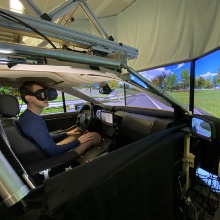Reading or even sleeping while driving a car but still being ready to take over behind the wheel in an emergency – once highly automated vehicles first appear on the road, the opportunities and requirements for drivers and passengers will change. Researchers at the University of Stuttgart are working with a number of partners from business and science to investigate how the interior of the vehicle will need to be designed in future to ensure comfort and safety under changed circumstances as part of the RUMBA research project funded by the Federal Ministry for Economic Affairs and Energy.
Developments towards automated driving are advancing steadily. Many driving functions can already be implemented from a technical perspective but so far the needs of the driver have been an afterthought, especially with regard to interior design. Against this background, the RUMBA project, which aims to create a positive user experience by means of a user-friendly interior design for automated driving functions, is developing the vision of an integrated concept of driving comfort for autonomous driving. In a consortium led by Robert Bosch GmbH, the Technical Design research and teaching area at the Institute for Engineering Design and Industrial Design (IKTD) at the University of Stuttgart is cooperating with well-known manufacturers, suppliers as well as small and medium-sized companies from the automotive industry. The project has been awarded with 10 million euros of funding by the German Federal Ministry for Economic Affairs and Energy (BMWi).
In order to turn the vision into reality, the researchers are firstly developing a new interior concept for cars and trucks. This means that the seats in a car may be positioned at the front or as in a lounge in future, while in a truck the driver’s cockpit may become an office workstation. Secondly, research is being carried out into adapting vehicle dynamics to future driving scenarios, for example to prevent the driver from spilling coffee on himself when accelerating. The aim of the project is to create several prototypes in which a symbiosis can be achieved of new interior concepts and adaptive vehicle dynamics.
User-oriented concepts and modular interiors
The focus of the Technical Design research and teaching area of the IKTD, for which the head of the concept development project is responsible, is a user-centered conceptual design of the interior. The focus is also on designing modular interiors and carrying out comprehensive studies. Here the IKTD contributes its expertise in dimensional conception, interaction between humans and machines and vehicle design.
For the testing phase, individuals are being sought to test the concepts by means of virtual reality, mock-ups and simulators as well as by using real and dynamic test vehicles.
Expert Contact:
Florian Reichelt, University of Stuttgart, Institute for Engineering Design and Industrial Design, Technical Design research and teaching area, phone: +49 (0)711 685 68218, e-mail


